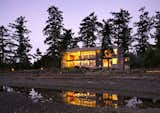TreeHugger
16 more photos
Credits
From INTERSTICE Architects
The project, from its initial discourse, forced the project stakeholders to reframe sustainability beyond LEED standards to encompass the ecological context of the island: its unique energy needs, its rain forest climate, the riparian flood plain, harsh weather conditions and local materials that would define the project and its ambitious goals. An ecological or “eco-systemic” thinking emerged as the basis for the project’s critical approach. A strict energy independence for the home itself was a given, calling for a 7.5 K photo voltaic array, electric boilers, LED fixtures, and radiant heating throughout, permitting “off grid” habitation through the frequent blackouts caused by storm conditions. From there the design brief went deeper into local materials, their maintenance and long term weathering capacities, and to the embodied energy in each. Sustainability was integrated from the small scale of engineered flooring, fiber reinforced concrete, and monolithic plastic paneling, to the macro scale of exposed fly-ash concrete, and Douglas fir cladding, and overall deployment of structures and systems.
The building was designed in deliberate harmony with the complex riparian ecosystem, its cycles and re-establishment patterns, in order to leverage the site’s qualities in a careful and sensitive manner to ensure the project long-term stewardship of the site and waterfront. The low profile vegetated Sea Wall was built completely from local stone and, in collaboration with the Federal Oceans and Fisheries Department, was carefully engineered to counteract coastal erosion by building up the existing littoral zone and beachfront while eventually being subsumed and forming part of the existing Natural Boundary.



















